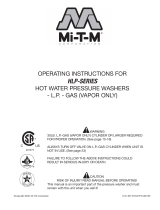
14 Operator's Manual
CAUTION
RISK OF DAMAGE.
DO NOT ALLOW SPRAY PATTERN
TO REMAIN ON A FIXED AREA
FOR AN EXTENDED PERIOD OF
TIME. POSSIBLE DAMAGE MAY
OCCUR TO THE AREA.
DANGER
RISK OF INJECTION CAUSING
SEVERE INJURY!
-KEEP CLEAR OF NOZZLE! NEVER
PLACE HAND OR FINGERS IN
FRONT OF NOZZLE!
-DO NOT DIRECT DISCHARGE
STREAM AT PEOPLE OR PETS!
-THIS PRODUCT IS TO BE
USED ONLY BY TRAINED
OPERATORS.
-AUTO START/STOP FEATURE
WILL SHUTDOWN THE
PRESSURE WASHER UNTIL GUN
IS TRIGGERED. TO PREVENT
ACCIDENTAL HIGH PRESSURE
DISCHARGE, DO NOT LEAVE
UNIT UNATTENDED WHILE IN
THIS MODE.
OPERATING INSTRUCTIONS
FLUSHING THE SYSTEM:
This unit has a steel coil which, after setting, will cause the water remaining in
the coil from the previous usage to turn brown or black. This water must be
ushed from the system before start-up. This procedure should be performed
without the high pressure hose, gun and dual lance assembly installed.
1. Turn on the water supply.
2. Move the pump switch to the "ON" position. Low pressure water will begin
owing from the water outlet. This allows the unit to ush any particles from
the system. The unit is ushed when the water is clear.
3. Once the system is ushed, move the pump switch to the "OFF" position
and connect the high pressure hose to the water outlet of the unit.
4. Connect the trigger gun and dual lance assembly to the high
pressure hose.
START-UP/COLD WATER OPERATION:
1. Refer to the "Safety Warnings" pgs. 4-7 before starting the unit.
2. Locate the Safety Decals on your unit and heed their warnings.
3. Ensure that the switch is in the "OFF" position.
4. Pointing the trigger gun in a safe direction, unlock the trigger gun and
squeeze the trigger. Brace yourself for possible gun kickback when the
pump starts.
5. Move power switch to the "ON" position.
6. Move the pump switch to the "ON" position.
7. Once the unit has started, perform the following procedures with the gun
open:
a. Inspect for system water leaks, oil leaks and fuel leaks.
If a leak is found, TURN UNIT OFF IMMEDIATELY! Be sure that all
damaged parts are replaced and that the mechanical problems are
corrected prior to operation of the unit. If you require service, contact
Customer Service.
b. Inspect high pressure hoses for kinking, cuts and leaks.
If a cut or leak is found, DO NOT TOUCH HOSE AT LEAK!!! TURN UNIT
OFF IMMEDIATELY! Replace hose before starting the unit. See "Risk
of Injection or Severe Cutting Injury" pg. 6. Be sure that all damaged
parts are replaced and that the mechanical problems are corrected
prior to operation of the unit. If you require service, contact Customer
Service.
8. At this point, the unit is operating as a cold water pressure washer. Trigger
the gun several times and try adjusting the water pressure by rotating the
grip on the dual lance. NEVER place hand or ngers in front of the nozzle
or look directly into the nozzle! High pressure water creates a risk of severe
injury!
9. Do not allow unit to operate in bypass mode (with trigger closed) for more
than ve minutes without triggering the gun. Failure to follow this simple
rule can cause premature failure of pump packings, resulting in costly pump
repair.
NOTE: This unit may be equipped with an Auto Start/Stop feature, the pressure
washer will shutdown if the gun is not triggered after a designated
amount of time. The pressure washer will start again once the gun
is triggered. The Auto Start/Stop feature is preset at the factory for
shutdown at 90 seconds. It can be adjusted by an Authorized Service
Technician to shutdown from no usage after a minimum of 3 seconds
to a maximum of 5 minutes.
10. Your pressure washer can deliver high pressure spray and a variety of
spray patterns using cold water. If you wish to use the Hot Water, Steam
application or Cleaning with Detergents, observe the following procedures.
HOT WATER OPERATION:
1. Follow the steps 1-9 outlined for Start-up / Cold Water Operation.
2. Move the burner switch to the “ON” position and the adjustable thermostat
clockwise to the desired setting.
3. Recheck the system for fuel leaks. If a fuel leak is found, TURN UNIT OFF
IMMEDIATELY! See “Risk of Explosion or Fire”, pg. 5.
NOTE: Upon initial start-up, water will begin turning hot in approximately 20
seconds and will reach maximum temperature in approximately 2-1/2
minutes providing the trigger remains squeezed. The burner will not
re when the trigger is released.
At this point, the unit will operate as a hot water pressure washer. Be extremely
cautious when adjusting the pressure and controlling the trigger gun/dual lance
assembly to avoid the possibility of burns.
WARNING
RISK OF BURN!
THE WATER TEMPERATURE
COULD BECOME VERY HOT
DURING HOT WATER/STEAM
OPERATION. BE CAUTIOUS
WHEN ADJUSTING PRESSURE
OR CONTROLLING THE TRIGGER
GUN/DUAL LANCE ASSEMBLY.
CAUTION
RISK OF UNIT DAMAGE.
BE CERTAIN THE HOSE, GUN
& DUAL LANCE ASSY. ARE
NOT CONNECTED TO THE
UNIT WHILE FLUSHING THE
SYSTEM. FLUSHING ALLOWS
MINERAL DEPOSITS TO BE
RELEASED FROM THE SYSTEM
WHICH WOULD OBSTRUCT
OR DAMAGE THE GUN AND
NOZZLE ASSEMBLY RESULTING
IN COSTLY REPAIRS.





























